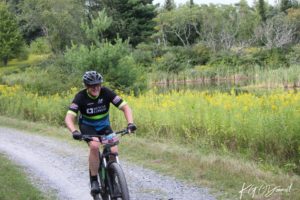Our pledge is to develop vibrant communities emboldened by outdoor recreation and natural environments connected to all Mountain Bikers not defined by a stereotype or riding ability.
As a riding community, how do we ensure that everyone who may be interested, has access to these same experiences and their benefits? Or put another way, how do we invite the world to participate in mountain biking? Feeling invited and receiving a little empathy instantly translates into fuel. Openly invited and properly inspired, more people may give riding a try.
VMBA has pledged in 2020 to explore and promote ways that we can invite the world to participate in mountain biking and build a more inclusive community. In doing so, we have launched our ‘What does a rider look like’ campaign. This campaign strives to connect with local riders to understand their background and their point of view on mountain biking from all the corners of Vermont. We reached out with our first interviewee – meet VMBA Member, Roxanne Bombardier.

Name:
Roxanne Bombardier
Home Chapter:
Richmond Mountain Trails
Favorite Trail:
This is tough to answer, I love Chamberlin Hill Trails, Full House, Up Dog, Gryla; believe it or not I enjoy climbing a lot. I am not a great downhill rider, I’m a bit risk-averse.
Favorite Riding Event/s:
Catamount Wednesday Night Races, Julbo Eastern Grind, Rooted Vermont Gravel Race, Muddy Onion, Rasputitsa, this goes on and on…
How did I get interested in riding:
I have been a lifelong cyclist since I was five when my family lived near San Francisco, California. We moved to Vermont in 1978 where I was horribly bullied and had a very difficult time; this led to problems that would plague me into adulthood. My cycling suffered in the Vermont climate and I struggled with obesity and other issues. I did cycle casually, I recall the first time I rode my Bianchi Broadway from Richmond to the “big city” of Burlington and it was such a shift for my mind to make that trip and what was possible on a bicycle.
I was first introduced to the modern incarnation of Mountain Biking in the early 1990s. Friends of mine had proper Diamondback mountain bikes and I borrowed one and attempted to keep up with them on rides. We would be riding and they would pull way ahead of me. They would stop for me to catch up and then take right off again as soon as I got there without giving me a chance to rest and this was discouraging at first, no one thought about inclusiveness then or making other riders feel very welcome. They figured keep up or tough luck, I did a couple more rides on borrowed bikes with them, and then I finally got a bike of my own.
I bought a $400 Giant Sedona from Essex Bicycles and loved it. My first proper ride on the bike was a Catamount Family Center, it was early summer 1993. I had not gone maybe half a mile and was traveling down a trail having a lovely time. Another rider approached me from the opposite direction and screamed at me “You’re going the wrong WAY idiot!” Later I found out that this was actually a 2-way trail, as were all the trails at Catamount then, that guy was just being a jerk. Mountain Bikers were NOT welcoming then, and I think the sport was hurt for it. Nonetheless I persisted… I stuck with it and soon was attending races, there is more to the story but that is for another time. Cliff Notes Version: Cycling in various forms, MTB, Gravel, Fat, even Road have helped me deal with mental and physical health issues to this day. I have always suffered more when there was less cycling in my life.
Best Advice:
Work with and support a well-established Local Bike Shop who can help you when you are in a pinch. They help you, you help them, a two way street. You will be helping your whole community. Be patient with yourself, build fitness slowly and carefully, ride with people who are faster than you, attend trainings, build skills, do not rush to go clipless – learn to be confident with flat pedals before going clipless.
We want to thank Roxanne for sharing her story with us and the mountain bike community. Individuals come from all different backgrounds and experiences – we are committed to promoting communities that are inclusive and celebrate people from all walks of life. We do so by recognizing that a mountain biker is not defined by any particular stereotype or riding ability. We will continuously explore and promote ways VMBA members can invite the world to participate in Vermont mountain biking and to be more inclusive in our riding community.
Please feel free to check out our Diversity, Equity & Inclusion pledge!
Stay tuned for more interviews as we explore – ‘What does a rider look like?’
